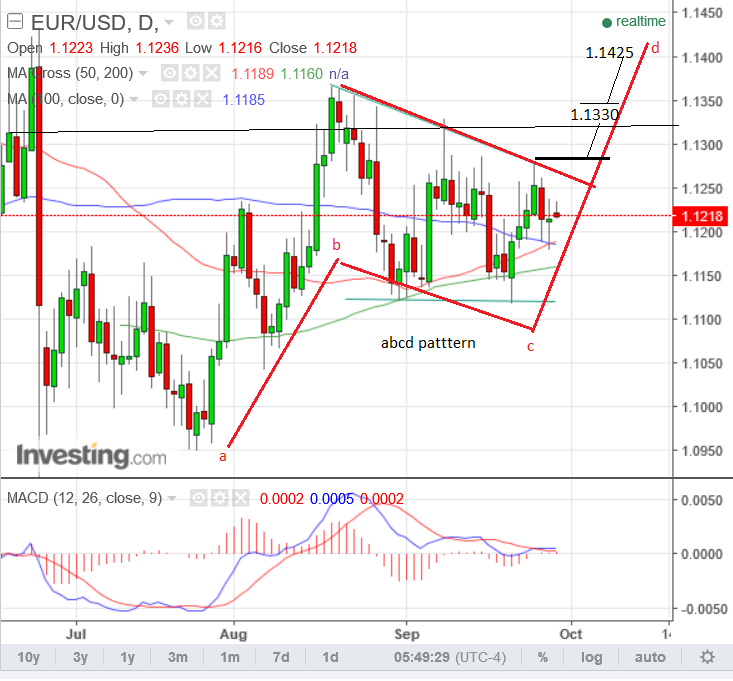EUR/USD Exchange Rate Gains Forecast by the Charts

Desite sentiment towards the Dollar improving of late, we still believe the EUR/USD wants to go higher.
The EUR/USD chart is showing a strong possibility of further upside in the short-term.
The pull-back from the August highs in EUR/USD has formed a flag-like consolidation which arguably indicates more upside on the horizon.
The red lines drawn on the chart show how price action resembles an abcd pattern which began at the July lows, with the current price action constituting the ‘b-c’ wave of the pattern:
It also suggests that ‘b-c’ will end soon and evolve into a ‘c-d’ up-wave, which is likely to be roughly equal in length to ‘a-b’.
This advocates a potential move up to as high as 1.1425 eventually, although initially we would be looking for a move above 1.1280 for confirmation of a bullish move higher to an initial target at 1.1330.
Interestingly the fact that current price action has stayed above the three largest moving averages (MA) – the 50, 100 and 200 day MA’s signifies it is underpinned by robust support, since the exchange rate would require a lot of ‘shock’ down-pressure to break below them.
“As the euro initially came under selling pressure, the 100-day moving average was tested but, ultimately, it was not undershot,” commented Ralf Umlauf of Helaba Economics Advisory Service.
Adding a more neutral overall view that, “the mid-term technical picture remains defined by sideways trading. However, further downside risk should emerge if the 200-day moving average of 1.1158 is undershot. Our favoured trading range: 1.1180 – 1.1280.”
Traders Turn Bullish on the US Dollar
Despite our call on EUR/USD looking to go higher, we note risks to the call in that sentiment towards the Dollar is improving.
CFTC data for the week of September 27th showed speculative investors adding again to aggregate (net) long USD positions, for a third consecutive week of gains.
The total bull bet on the USD rose by some USD 3bn in the week to reach USD12.4bn, the largest aggregate Bet on the USD in two months.
ECB to Support Euro, Inflation is a Dampener
From a fundamental perspective the pair remains pressured to the downside as a result of recent data showing a slow-down in inflation.
The latest was Thursday’s September CPI data from Spain, which showed an unexpectedly high rise of 0.3% on a year-on-year basis, but a below-expectations 0.1% print mom from 0.2% expected, the same undershoot for HICP inflation yoy (EU harmonized) - a gauge that the central bank pay more attention to - and a lower-than-forecast 0.8% result from 0.9% previously mom.
Economists at Citibank maintain they expect an increase in stimulus from the ECB in December as inflation is likely to remain subdued.
“Weak domestically-generated price and wage pressures together with some downward effects from imported inflation imply euro area inflation will be low over the next couple of years and despite recent relatively-hawkish comments from ECB officials, will likely trigger more monetary policy stimulus in the form of an extension of its asset purchases program in December,” remarked Citibank.
Further policy measures could ensure any strength in the EUR/USD remains limited.
Of more concern, however, are the current increasing fears about the health of German banks, illustrated by the 40 basis point increase in Credit Default Swaps, which are a type of insurance against companies going bust, for Deutsche bank.
Citi remark that the lack of follow-through weakness for the euro stems from the large amount of support put in place for Eurozone banks from ECB’s stimulus actions, including the asset purchase programme and the TLTRO, long-term cheap loans.
“EUR appears to be lagging concerns about the German banking sector that are currently being expressed in sharply higher CDS spreads," note Citi.
However, analyst point out ECB liquidity injections via its stimulus measures have greatly alleviated liquidity pressure via its PSPP and TLTROs and which appears to have broken the link between the exchange rate and financials for now as contagion to broader financials or equities so far has been limited.











